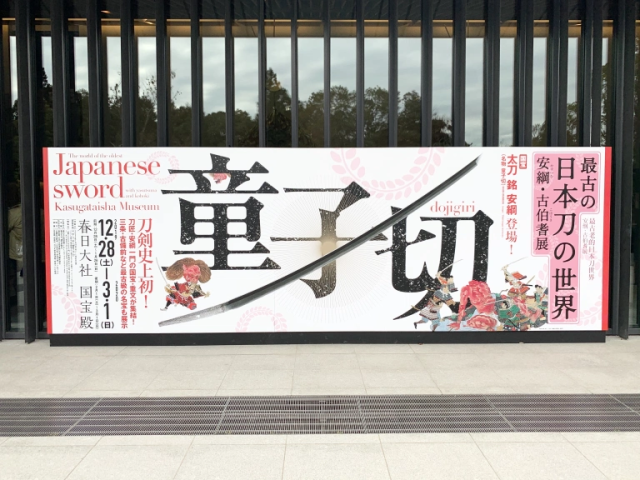
Legendary blade is a an official natural treasure, and presented in a uniquely beautiful way.
The Five Swords Under Heaven might sound like the reward you get for completing a late-game optional side quest in Final Fantasy, but it’s an actual designated set of the most beautiful and culturally prized swords to have ever been created in Japan. A while back, we saw one of the five, Mikazuki (“Crescent Moon”) at Tokyo’s National Museum, and this week we had the opportunity to gaze upon another: Dojigiri.
As you can guess, chances to see the Five Swords Under Heaven don’t happen every day. One is straight-up owned by the Japanese Imperial Family, and three, including Dojigiri, are officially designated national treasures of the country. So when we found out that Dojigiri was being displayed as part of an exhibition being held at Kasuga Shrine in Nara (which also recently displayed the famed Brother Katana set), we didn’t hesitate to hop on the Shinkansen and check it out.
▼ Dojigiri
Dojigiri is so old that it’s hard to say exactly how old it is, but some estimate its age at over 1,000 years. What we do know is that the sword was struck by famous swordsmith Yasutsuna, who lived in Hoki, a part of Japan in present-day Tottori Prefecture, during the Heian Period.
If you’ve got a bit of knowledge about Japanese swords, you’ve probably noticed that a lot of them have names with “giri” or “kiri” in them. Both come from the word kiru, literally “cut,” which can also be used to mean “kill” or “slay.” In the case of Dojigiri, it’s said that the sword was used by Minamoto no Yorimitsu, a samurai warlord, to slay Shuten-doji, an oni (demon) who, along with his minions, terrorized the capital city of Kyoto.
▼ Shuten-doji, after having been relieved of his head by Dojigiri
While seeing one of the Five Swords Under Heaven is always an unforgettable experience for history buffs, the way Kasuga Shrine’s museum is displaying Dojigiri is particularly special. Rather than place the blade in a display case along one of the walls, Dojigiri is housed in a standing case in the center of the room, enabling visitors to see it from a variety of angles.
▼ Including this perspective, ostensibly the one Shuten-doji saw the sword from as it came for his head.
As a matter of fact, if no one happens to be standing on the other side of the case from you, the reflection in the glass can allow you to view both surfaces of the blade at the same time.
▼ Even Dojigiri’s shadow looks awesome.
As we’ve talked about before, some of the most intriguing aesthetic aspects of a Japanese sword reveal themselves when you take a look at the flat of the blade. For starters, there’s the hamon, the tempering line, which can be as straight as the surface of a windless lake, or undulate like the waves of a roiling sea.
Dojigiri’s hamon is especially expressive, roaming over enough of the blade that different sections almost look like they’re from different swords.
But what’s arguably the most impressive thing about Dojigiri’s appearance is the amount of utsuri (“reflection”) it has. In katana parlance, utsuri refers to the amount of reflective shine in the flat of the blade between the hamon and unsharpened interior edge. A number of factors influence the amount of utsuri, including the quality of the metal used, and the amount of time the material is heated and quenched for. While Yasutsuna’s specific smithing technique has been lost to the ages, the result is a dazzling usturi far beyond what you’ll see in just about any other Japanese sword.
Dojigiri will be on display, and shining brightly, until March 1.
Event information
The World of the Oldest Japanese Swords / 最古の日本刀の世界
Venue: Kasugataisha Museum / 春日大社国宝殿
Address: Nara-ken, Nara-shi, Kasuganocho 160
奈良県奈良市春日野町160
Open 10 a.m.-5 p.m.
Admission 1,000 yen (US$9)
Exhibition until March 1
Website
Photos ©SoraNews24
● Want to hear about SoraNews24’s latest articles as soon as they’re published? Follow us on Facebook and Twitter!
[ Read in Japanese ]
Casey hasn’t quite achieved national treasure status, but you can follow him on Twitter anyway.
[ Read in Japanese ]

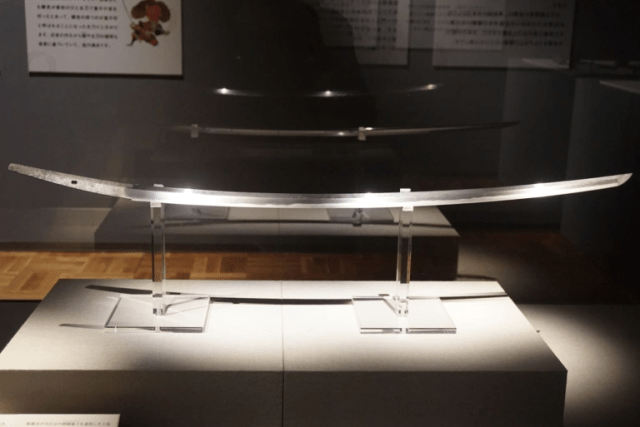
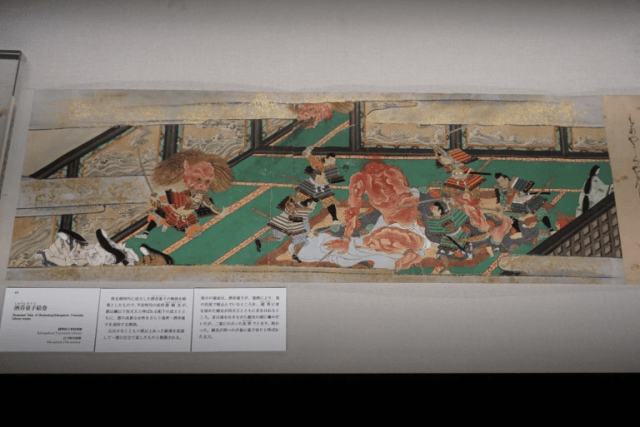
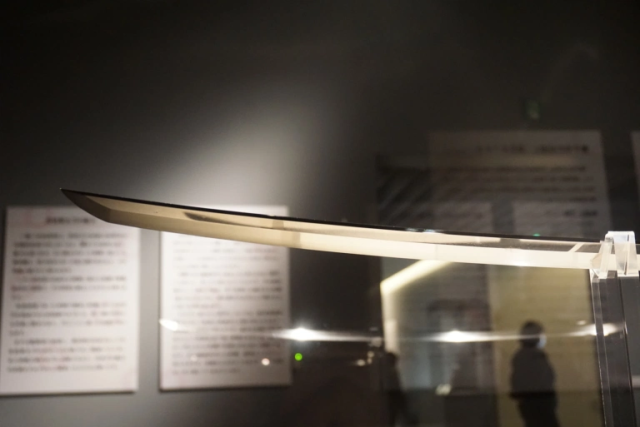

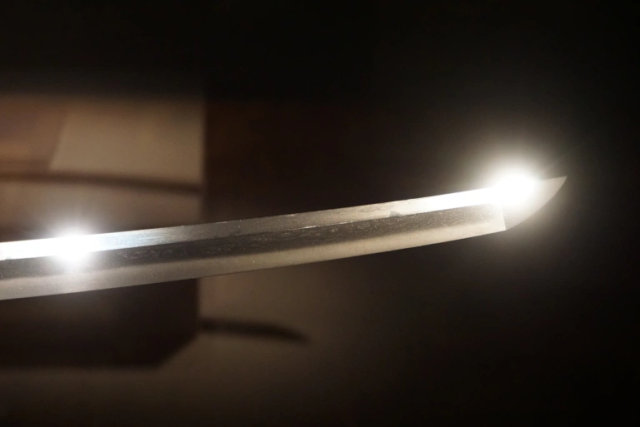

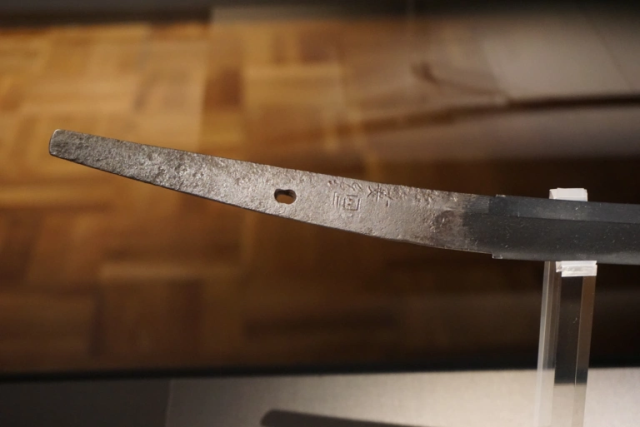
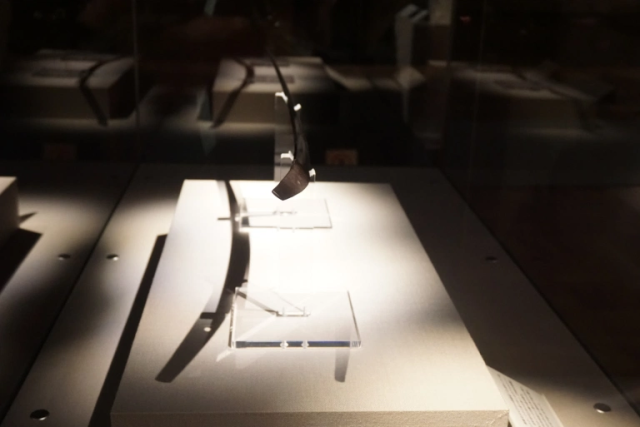
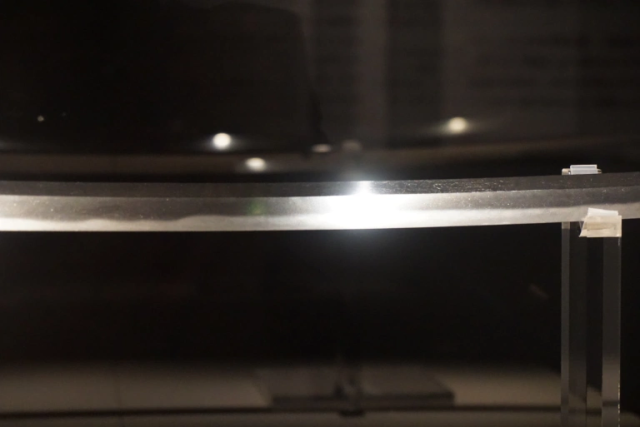

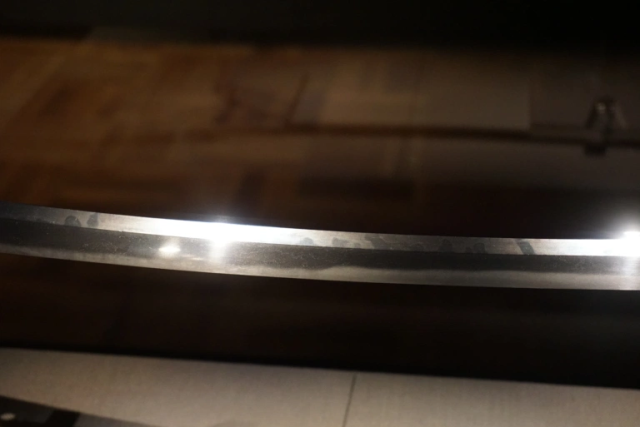
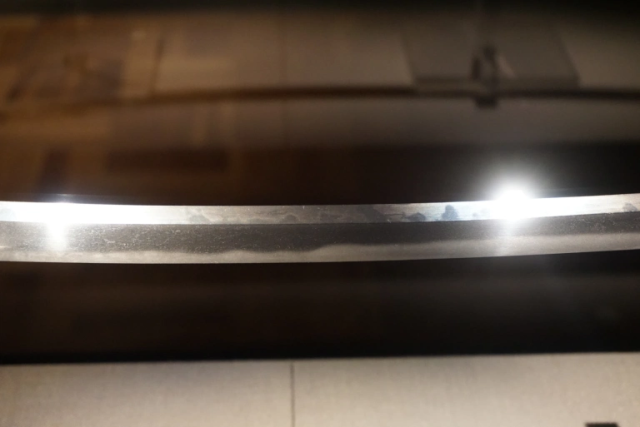
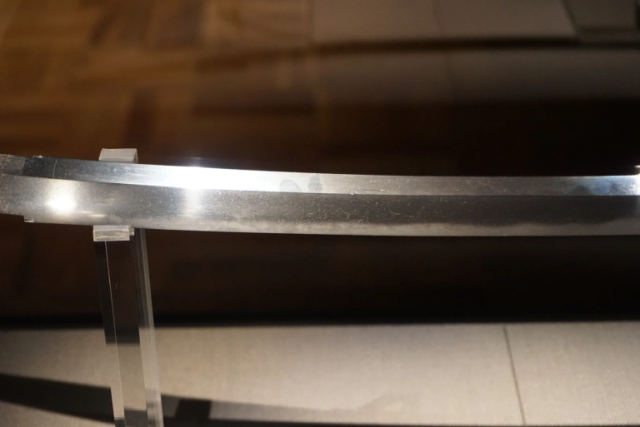
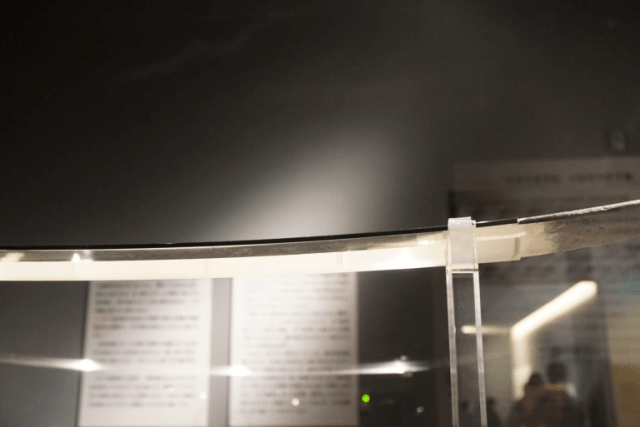
 Dojigiri, the millennium-old katana said to have slain a demon, is now on display in Tokyo【Pics】
Dojigiri, the millennium-old katana said to have slain a demon, is now on display in Tokyo【Pics】 Japan’s legendary Brother Katana might not be brothers after all? Investigating the mystery【Pics】
Japan’s legendary Brother Katana might not be brothers after all? Investigating the mystery【Pics】 Legendary crescent moon katana, one of Japan’s Five Swords Under Heaven, now on display in Tokyo
Legendary crescent moon katana, one of Japan’s Five Swords Under Heaven, now on display in Tokyo This hotel has one of the coolest katana collections in Japan, and admission is totally free【Pics】
This hotel has one of the coolest katana collections in Japan, and admission is totally free【Pics】 Real-life Rurouni Kenshin reverse-blade katana, forged by master swordsmith, now on display【Pics】
Real-life Rurouni Kenshin reverse-blade katana, forged by master swordsmith, now on display【Pics】 Japan’s new difficult-to-drink-from beer glass protects your liver, but it’s a brutal experience
Japan’s new difficult-to-drink-from beer glass protects your liver, but it’s a brutal experience Demon Slayer: Kimetsu no Yaiba gets new roller coaster attractions and food at Universal Studios Japan
Demon Slayer: Kimetsu no Yaiba gets new roller coaster attractions and food at Universal Studios Japan How to order snacks on a Shinkansen bullet train in Japan
How to order snacks on a Shinkansen bullet train in Japan Burger King Japan suddenly adds Dr. Pepper and Dr. Pepper floats to its menu nationwide
Burger King Japan suddenly adds Dr. Pepper and Dr. Pepper floats to its menu nationwide New Pokémon ice cream, dessert drinks, and cool merch coming to Baskin-Robbins Japan【Pics】
New Pokémon ice cream, dessert drinks, and cool merch coming to Baskin-Robbins Japan【Pics】 Caffeinated ramen for gamers that you can eat with one hand going on sale in Japan
Caffeinated ramen for gamers that you can eat with one hand going on sale in Japan New samurai glasses are Japan’s latest weird must-have souvenir
New samurai glasses are Japan’s latest weird must-have souvenir McDonald’s adds new watermelon frappe and fruity macaron to its menu in Japan
McDonald’s adds new watermelon frappe and fruity macaron to its menu in Japan Princesses, fruits, and blacksmiths: Study reveals the 30 most unusual family names in Japan
Princesses, fruits, and blacksmiths: Study reveals the 30 most unusual family names in Japan We check out the local flavors of the commonly confused Ome and Aomi areas of Tokyo in one day
We check out the local flavors of the commonly confused Ome and Aomi areas of Tokyo in one day Nintendo history you can feel – Super NES, N64, and GameCube controllers become capsule toys
Nintendo history you can feel – Super NES, N64, and GameCube controllers become capsule toys Hello, cosmetics! Clinique teams up with Hello Kitty this summer for first-time collaboration
Hello, cosmetics! Clinique teams up with Hello Kitty this summer for first-time collaboration “The most Delicious Cup Noodle in history” – Japan’s French Cup Noodle wins our heart【Taste test】
“The most Delicious Cup Noodle in history” – Japan’s French Cup Noodle wins our heart【Taste test】 Starbucks releases a cute Frappuccino and Unicorn Cake…but not in Japan
Starbucks releases a cute Frappuccino and Unicorn Cake…but not in Japan Kyoto Tower mascot termination reveals dark side behind cute Japanese characters
Kyoto Tower mascot termination reveals dark side behind cute Japanese characters McDonald’s Japan’s Soft Twist Tower: A phantom ice cream only sold at select branches
McDonald’s Japan’s Soft Twist Tower: A phantom ice cream only sold at select branches Yabai Ramen: What makes this Japanese ramen so dangerous?
Yabai Ramen: What makes this Japanese ramen so dangerous? Finally! Nintendo Japan expands Switch 8-bit controller sales to everybody, Online member or not
Finally! Nintendo Japan expands Switch 8-bit controller sales to everybody, Online member or not Japanese government wants to build luxury resorts in all national parks for foreign tourists
Japanese government wants to build luxury resorts in all national parks for foreign tourists To combat declining birth rate, Japan to begin offering “Breeding Visas” to foreigners
To combat declining birth rate, Japan to begin offering “Breeding Visas” to foreigners 10 things you should buy at 7-Eleven in Japan
10 things you should buy at 7-Eleven in Japan Studio Ghibli releases anime heroine cosplay dresses that are super comfy to wear
Studio Ghibli releases anime heroine cosplay dresses that are super comfy to wear Woman charged for driving suitcase without a license in Osaka
Woman charged for driving suitcase without a license in Osaka Studio Ghibli unveils My Neighbour Totoro miniature house model
Studio Ghibli unveils My Neighbour Totoro miniature house model Kyoto experiencing problems with foreign tourists not paying for bus fares, but not on purpose
Kyoto experiencing problems with foreign tourists not paying for bus fares, but not on purpose Fighting mild hunger with a Japanese soda that turns into jelly in the stomach【Taste test】
Fighting mild hunger with a Japanese soda that turns into jelly in the stomach【Taste test】 Studio Ghibli’s Howl’s Moving Castle tapestry unveiled in Japan for first time
Studio Ghibli’s Howl’s Moving Castle tapestry unveiled in Japan for first time McDonald’s new Happy Meals offer up cute and practical Sanrio lifestyle goods
McDonald’s new Happy Meals offer up cute and practical Sanrio lifestyle goods Sales of Japan’s most convenient train ticket/shopping payment cards suspended indefinitely
Sales of Japan’s most convenient train ticket/shopping payment cards suspended indefinitely Sold-out Studio Ghibli desktop humidifiers are back so Totoro can help you through the dry season
Sold-out Studio Ghibli desktop humidifiers are back so Totoro can help you through the dry season Japanese government to make first change to romanization spelling rules since the 1950s
Japanese government to make first change to romanization spelling rules since the 1950s Foreigner’s request for help in Tokyo makes us sad for the state of society
Foreigner’s request for help in Tokyo makes us sad for the state of society Ghibli founders Toshio Suzuki and Hayao Miyazaki contribute to Japanese whisky Totoro label design
Ghibli founders Toshio Suzuki and Hayao Miyazaki contribute to Japanese whisky Totoro label design Doraemon found buried at sea as scene from 1993 anime becomes real life【Photos】
Doraemon found buried at sea as scene from 1993 anime becomes real life【Photos】 Tokyo’s most famous Starbucks is closed
Tokyo’s most famous Starbucks is closed Real-life Rurouni Kenshin katana forged based on sword of series’ most merciless villain【Photos】
Real-life Rurouni Kenshin katana forged based on sword of series’ most merciless villain【Photos】 Real-life Rurouni Kenshin reverse-blade katana now on display in Tokyo【Photos】
Real-life Rurouni Kenshin reverse-blade katana now on display in Tokyo【Photos】 Swords of famous samurai reborn as beautiful kitchen knives from Japan’s number-one katana town
Swords of famous samurai reborn as beautiful kitchen knives from Japan’s number-one katana town Genuine Muramasa blade and Muromachi katana on display at Tokyo’s Touken Ranbu store【Photos】
Genuine Muramasa blade and Muromachi katana on display at Tokyo’s Touken Ranbu store【Photos】 Amazing exhibition of Japan’s legendary “cursed katana” is going on right now【Photos】
Amazing exhibition of Japan’s legendary “cursed katana” is going on right now【Photos】 Japan is running out of swordsmiths, and a strict apprenticeship requirement is a big reason why
Japan is running out of swordsmiths, and a strict apprenticeship requirement is a big reason why Real-life Rurouni Kenshin reverse-blade sword to be displayed in Tokyo
Real-life Rurouni Kenshin reverse-blade sword to be displayed in Tokyo Japanese samurai sword ice cream crafted by master swordsmith from famous katana town of Seki
Japanese samurai sword ice cream crafted by master swordsmith from famous katana town of Seki 59-year-old Japanese master swordsman shows off awesome two-sword samurai slash【Video】
59-year-old Japanese master swordsman shows off awesome two-sword samurai slash【Video】 Slice into a traditional sweet range with some of Japan’s most famous swords
Slice into a traditional sweet range with some of Japan’s most famous swords Japanese city offering authentic handcrafted swords in exchange for “tax” payments
Japanese city offering authentic handcrafted swords in exchange for “tax” payments One Piece anime katanas recreated as exquisite letter openers by Japan’s swordsmith legacy heirs
One Piece anime katanas recreated as exquisite letter openers by Japan’s swordsmith legacy heirs Final Fantasy artist Yoshitaka Amano anthropomorphizes katana made from a meteorite
Final Fantasy artist Yoshitaka Amano anthropomorphizes katana made from a meteorite Scholars confirm first discovery of Japanese sword from master bladesmith Masamune in 150 years
Scholars confirm first discovery of Japanese sword from master bladesmith Masamune in 150 years We visit the awesome new Samurai Museum in Shinjuku【Photos】
We visit the awesome new Samurai Museum in Shinjuku【Photos】 Wear a genuine piece of Japanese sword around your neck with beautiful new jewellery range
Wear a genuine piece of Japanese sword around your neck with beautiful new jewellery range
Leave a Reply